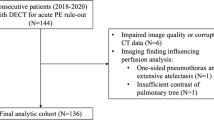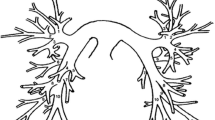Abstract
Objective
To investigate the role of perfusion defect (PD) size on dual energy CT pulmonary blood volume assessment as predictor of right heart strain and patient outcome and its correlation with d-dimer levels in acute pulmonary embolism (PE).
Methods
53 patients with acute PE who underwent DECT pulmonary angiography were retrospectively analyzed. Pulmonary PD size caused by PE was measured on DE iodine maps and quantified absolutely (VolPD) and relatively to the total lung volume (RelPD). Signs of right heart strain (RHS) on CT were determined. Information on d-dimer levels and readmission for recurrent onset of PE and death was collected.
Results
D-dimer level was mildly (r = 0.43–0.47) correlated with PD size. Patients with RHS had significantly higher VolPD (215 vs. 73 ml) and RelPD (9.9 vs. 2.9%) than patients without RHS (p < 0.003). There were 2 deaths and 1 readmission due of PE in 18 patients with >5% RelPD, while no such events were found for patients with <5% RelPD.
Conclusion
Pulmonary blood volume on DECT in acute PE correlates with RHS and appears to be a predictor of patient outcome in this pilot study.


Similar content being viewed by others
References
Lualdi JC, Goldhaber SZ (1995) Right ventricular dysfunction after acute pulmonary embolism: pathophysiologic factors, detection, and therapeutic implications. Am Heart J 130:1276–1282
Wolfe MW, Lee RT, Feldstein ML, Parker JA, Come PC, Goldhaber SZ (1994) Prognostic significance of right ventricular hypokinesis and perfusion lung scan defects in pulmonary embolism. Am Heart J 127:1371–1375
Remy-Jardin M, Pistolesi M, Goodman LR, Gefter WB, Gottschalk A, Mayo JR, Sostman HD (2007) Management of suspected acute pulmonary embolism in the era of CT angiography: a statement from the Fleischner Society. Radiology 245:315–329
Schoepf UJ, Costello P (2004) CT angiography for diagnosis of pulmonary embolism: state of the art. Radiology 230:329–337
Stein PD, Fowler SE, Goodman LR, Gottschalk A, Hales CA, Hull RD, Leeper KV, Popovich J, Quinn DA, Sos TA, Sostman HD, Tapson VF, Wakefield TW, Weg JG, Woodard PK (2006) Multidetector computed tomography for acute pulmonary embolism. N Engl J Med 354:2317–2327
Torbicki A, Perrier A, Konstantinides S, Agnelli G, Galie N, Pruszczyk P, Bengel F, Brady AJ, Ferreira D, Janssens U, Klepetko W, Mayer E, Remy-Jardin M, Bassand JP, Vahanian A, Camm J, De Caterina R, Dean V, Dickstein K, Filippatos G, Funck-Brentano C, Hellemans I, Kristensen SD, McGregor K, Sechtem U, Silber S, Tendera M, Widimsky P, Zamorano JL, Zamorano JL, Andreotti F, Ascherman M, Athanassopoulos G, De Sutter J, Fitzmaurice D, Forster T, Heras M, Jondeau G, Kjeldsen K, Knuuti J, Lang I, Lenzen M, Lopez-Sendon J, Nihoyannopoulos P, Perez Isla L, Schwehr U, Torraca L, Vachiery JL (2008) Guidelines on the diagnosis and management of acute pulmonary embolism: the Task Force for the Diagnosis and Management of Acute Pulmonary Embolism of the European Society of Cardiology (ESC). Eur Heart J 29:2276–2315
Araoz PA, Gotway MB, Trowbridge RL, Bailey RA, Auerbach AD, Reddy GP, Dawn SK, Webb WR, Higgins CB (2003) Helical CT pulmonary angiography predictors of in-hospital morbidity and mortality in patients with acute pulmonary embolism. J Thorac Imaging 18:207–216
Collomb D, Paramelle PJ, Calaque O, Bosson JL, Vanzetto G, Barnoud D, Pison C, Coulomb C, Ferettis G (2003) Severity assessment of acute pulmonary embolism: evaluation using helical CT. Eur Radiol 13:1508–1514
Ghaye B, Ghuysen A, Bruyere PJ, D’Orio V, Dondelinger RF (2006) Can CT pulmonary angiography allow assessment of severity and prognosis in patients presenting with pulmonary embolism? What the radiologist needs to know. Radiographics 26:23–39, discussion 39–40
Ghaye B, Ghuysen A, Willems V, Lambermont B, Gerard P, D’Orio V, Gevenois PA, Dondelinger RF (2006) Severe pulmonary embolism: pulmonary artery clot load scores and cardiovascular parameters as predictors of mortality. Radiology 239:884–891
van der Meer RW, Pattynama PM, van Strijen MJ, van den Berg-Huijsmans AA, Hartmann IJ, Putter H, de Roos A, Husiman MV (2005) Right ventricular dysfunction and pulmonary obstruction index at helical CT: prediction of clinical outcome during 3-month follow-up in patients with acute pulmonary embolism. Radiology 235:798–803
Menendez R, Nauffal D, Cremades MJ (1998) Prognostic factors in restoration of pulmonary flow after submassive pulmonary embolism: a multiple regression analysis. Eur Respir J 11:560–564
Nauffal Manzur D, Menendez Villanueva R, Cremades Romero MJ (1997) The prognostic factors for early mortality and for total or partial gammagraphic resolution in venous thromboembolic disease. Arch Bronconeumol 33:220–224
Prediletto R, Paoletti P, Fornai E, Perissinotto A, Petruzzelli S, Formichi B, Ruschi S, Palla A, Giannella-Neto A, Giuntini C (1990) Natural course of treated pulmonary embolism. Evaluation by perfusion lung scintigraphy, gas exchange, and chest roentgenogram. Chest 97:554–561
Johnson TR, Krauss B, Sedlmair M, Grasruck M, Bruder H, Morhard D, Fink C, Weckbach S, Lenhard M, Schmidt B, Flohr T, Reiser MF, Becker CR (2007) Material differentiation by dual energy CT: initial experience. Eur Radiol 17:1510–1517
Zatz LM (1976) The effect of the kVp level on EMI values. Selective imaging of various materials with different kVp settings. Radiology 119:683–688
Ferda J, Ferdova E, Mirka H, Baxa J, Bednarova A, Flohr T, Schmidt B, Matejovic M, Kreuzberg B (2009) Pulmonary imaging using dual-energy CT, a role of the assessment of iodine and air distribution. Eur J Radiol. doi:10.1016/j.ejrad.2009.08.005DOI:dx.doi.org
Pontana F, Faivre JB, Remy-Jardin M, Flohr T, Schmidt B, Tacelli N, Pansini V, Remy J (2008) Lung perfusion with dual-energy multidetector-row CT (MDCT): feasibility for the evaluation of acute pulmonary embolism in 117 consecutive patients. Acad Radiol 15:1494–1504
Thieme SF, Becker CR, Hacker M, Nikolaou K, Reiser MF, Johnson TR (2008) Dual energy CT for the assessment of lung perfusion - correlation to scintigraphy. Eur J Radiol 68:369–374
Thieme SF, Johnson TR, Lee C, McWilliams J, Becker CR, Reiser MF, Nikolaou K (2009) Dual-energy CT for the assessment of contrast material distribution in the pulmonary parenchyma. Am J Roentgenol 193:144–149
Zhang LJ, Chai X, Wu SY, Zhao YE, Hu XB, Hu YX, Xue YB, Yang GF, Zhu H, Lu GM (2009) Detection of pulmonary embolism by dual energy CT: correlation with perfusion scintigraphy and histopathological findings in rabbits. Eur Radiol 19:2844–2854
Bauer RW, Kerl JM, Weber E, Weisser P, Korkusuz H, Lehnert T, Jacobi V, Vogl TJ (2010) Lung perfusion analysis with dual energy CT in patients with suspected pulmonary embolism - Influence of window settings on the diagnosis of underlying pathologies of perfusion defects. Eur J Radiol. doi:10.1016/j.ejrad.2010.09.009
Chae EJ, Seo JB, Jang YM, Krauss B, Lee CW, Lee HJ, Song KS (2010) Dual-energy CT for assessment of the severity of acute pulmonary embolism: pulmonary perfusion defect score compared with CT angiographic obstruction score and right ventricular/left ventricular diameter ratio. Am J Roentgenol 194:604–610
Zhang LJ, Yang GF, Zhao YE, Zhou CS, Lu GM (2009) Detection of pulmonary embolism using dual-energy computed tomography and correlation with cardiovascular measurements: a preliminary study. Acta Radiol 50:892–901
Grau E, Tenias JM, Soto MJ, Gutierrez MR, Lecumberri R, Perez JL, Tiberio G (2007) D-dimer levels correlate with mortality in patients with acute pulmonary embolism: Findings from the RIETE registry. Crit Care Med 35:1937–1941
Jeebun V, Doe SJ, Singh L, Worthy SA, Forrest IA (2009) Are clinical parameters and biomarkers predictive of severity of acute pulmonary emboli on CTPA? QJM 103:91–97
Klok FA, Van Der Bijl N, Eikenboom HC, Van Rooden CJ, De Roos A, Kroft LJ, Huisman MV (2010) Comparison of CT assessed right ventricular size and cardiac biomarkers for predicting short-term clinical outcome in normotensive patients suspected of having acute pulmonary embolism. J Thromb Haemost 8:853–856
Laporte S, Mismetti P, Decousus H, Uresandi F, Otero R, Lobo JL, Monreal M (2008) Clinical predictors for fatal pulmonary embolism in 15,520 patients with venous thromboembolism: findings from the Registro Informatizado de la Enfermedad TromboEmbolica venosa (RIETE) Registry. Circulation 117:1711–1716
Lobo JL, Zorrilla V, Aizpuru F, Grau E, Jimenez D, Palareti G, Monreal M (2009) D-dimer levels and 15-day outcome in acute pulmonary embolism. Findings from the RIETE Registry. J Thromb Haemost 7:1795–1801
Singanayagam A, Scally C, Al-Khairalla MZ, Leitch L, Hill LE, Chalmers JD, Hill AT (2010) Are biomarkers additive to pulmonary embolism severity index for severity assessment in normotensive patients with acute pulmonary embolism? QJM. doi:10.1093/qjmed/hcq168
Quiroz R, Kucher N, Schoepf UJ, Kipfmueller F, Solomon SD, Costello P, Goldhaber SZ (2004) Right ventricular enlargement on chest computed tomography: prognostic role in acute pulmonary embolism. Circulation 109:2401–2404
Schoepf UJ, Kucher N, Kipfmueller F, Quiroz R, Costello P, Goldhaber SZ (2004) Right ventricular enlargement on chest computed tomography: a predictor of early death in acute pulmonary embolism. Circulation 110:3276–3280
Kjaergaard J, Schaadt BK, Lund JO, Hassager C (2008) Quantification of right ventricular function in acute pulmonary embolism: relation to extent of pulmonary perfusion defects. Eur J Echocardiogr 9:641–645
Acknowledgements
Ralf W. Bauer and J. Matthias Kerl: Research consultants and Speaker’s Bureau Siemens AG
Author information
Authors and Affiliations
Corresponding author
Rights and permissions
About this article
Cite this article
Bauer, R.W., Frellesen, C., Renker, M. et al. Dual energy CT pulmonary blood volume assessment in acute pulmonary embolism – correlation with D-dimer level, right heart strain and clinical outcome. Eur Radiol 21, 1914–1921 (2011). https://doi.org/10.1007/s00330-011-2135-1
Received:
Revised:
Accepted:
Published:
Issue Date:
DOI: https://doi.org/10.1007/s00330-011-2135-1




